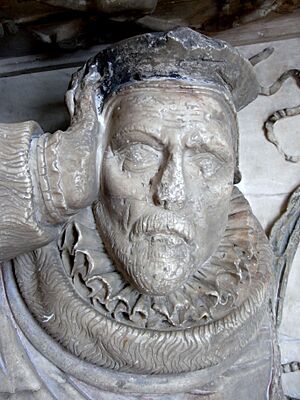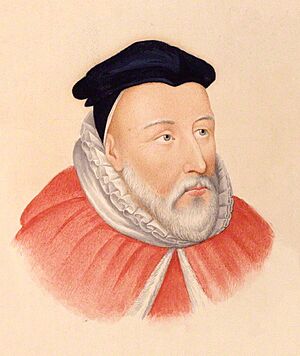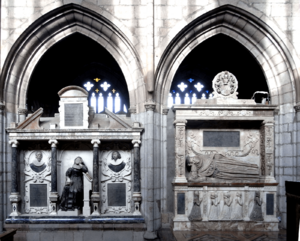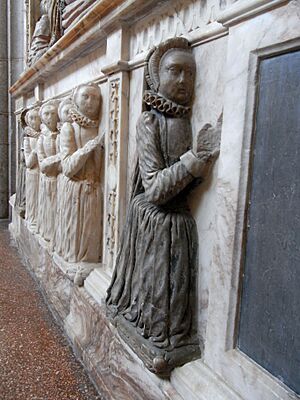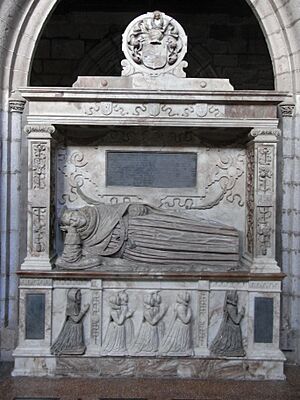William Peryam facts for kids
Sir William Peryam (born 1534, died October 9, 1604) was an important English judge. He lived in a place called Little Fulford near Crediton in Devon. In 1593, he became the Lord Chief Baron of the Exchequer, which was a very high legal position. Queen Elizabeth I also made him a knight.
Contents
Early Life and Family
William Peryam was born in Exeter. He was the oldest son of John Peryam, who was the mayor of Exeter twice. His mother was Elizabeth Hone. We know the year he was born, but not the exact day or month.
William was a cousin to Sir Thomas Bodley, who started the famous Bodleian Library. Like the Bodley family, the Peryams were early Protestants. This was a bit risky when Queen Mary I was in power, as she persecuted Protestants.
However, when Queen Elizabeth I became queen, the family did very well. William became a top lawyer. His younger brother, John Peryam, was elected to Parliament four times and also became Mayor of Exeter.
Education and Early Career
William first went to school in Exeter. Then, he studied at Exeter College, Oxford. In 1551, he became a fellow there.
A few months later, he moved to London. He studied law at the Middle Temple, which is one of the four Inns of Court where lawyers are trained. He officially became a lawyer in 1565.
Rising Through the Legal Ranks
In 1568, William Peryam faced a small challenge. He was asked to go to Ireland to work as a judge. He wrote to important people, explaining that he had a wife and children and was not in good health. It seems he managed to avoid moving to Ireland.
After this, his career as a lawyer grew steadily.
- In 1575, he became a serjeant-at-law, a senior type of lawyer.
- In 1581, he became a Judge of the Court of Common Pleas.
- His highest role came in January 1593. He was made a knight and became the Lord Chief Baron of the Exchequer. This meant he was the chief judge of the court that handled government money matters.
People at the time noted that Queen Elizabeth I was careful about making people knights. She waited until William Peryam had been a judge for twelve years. This showed how much she valued his work.
Homes and Land
Sir William Peryam bought several important pieces of land and homes near Crediton. These included:
- Fulford: He bought this land and built a "fayre howse" (a beautiful house) where he lived.
- Little Fulford: This was in the parish of Shobrooke. It later went to his daughters.
- Manor of Shobrooke: He bought this from Richard Carew.
- Creedy Wiger: He also built another "fayre dwellinge howse" here.
- Templeton: He bought this and gave it to his eldest daughter, Mary, when she got married.
Over time, many of these lands ended up with the Tuckfield family, who made Little Fulford their main home for many years.
Family Life and Marriages
Sir William Peryam was married three times:
- First Wife: Margery Holcote. They did not have any children.
- Second Wife: Anne Parker. With Anne, he had four daughters. All of them married into important families in the West Country of England.
- Mary Peryam (died 1606): She was the oldest daughter. She married Sir William Pole, who was a historian of Devon.
- Elizabeth Peryam (1571–1635): She married Sir Robert Basset. She inherited Little Fulford, but her husband later sold it.
- Jane Peryam (1572–1620): She married twice. First to Thomas Poyntz, and then to Thomas Docwra.
- Anne Peryam: She married William Williams.
- Third Wife: Elizabeth Bacon. She was the half-sister of the famous Sir Francis Bacon. This was also her third marriage. They did not have any children together.
Monuments to Daughters
Mary Peryham's Monument
There is a monument to Mary Peryham in Colyton Church. It shows the family symbols of both the Pole and Peryam families. The monument says she was the eldest daughter of Sir William Peryam and the wife of Sir William Pole. She had four sons and five daughters with him. She died on May 2, 1605, at the age of 38.
Elizabeth Peryham's Monument
In Heanton Punchardon Church, there is a monument for Elizabeth Peryam. She was the daughter of Sir William Peryam and the wife of Sir Robert Bassett. The monument has her family symbol (Peryam's arms) on it. It describes her as a good, wise, and kind person who helped the poor. Her oldest son, Arthur Bassett, put up the monument in 1635.
Death and Burial
Sir William Peryam died on October 9, 1604, when he was 70 years old. He passed away at his home in Little Fulford, near Crediton in Devon. He had served as a judge in the Exchequer court for almost twelve years.
His funeral and burial in Crediton Church were very important events. Many people attended, including important local figures and heralds (officials who manage ceremonies and family symbols).
Monument in Crediton Church
Sir William Peryam's monument is in the large Crediton parish church. It is placed in a very important spot, on the north side of the main altar area (chancel).
The monument shows a lifelike statue of him lying down, with his head resting on his hand. He is wearing a special chain called a Collar of Esses, which was a symbol of loyalty to the king or queen. Below his statue, there are smaller sculptures of his three wives kneeling, along with his four daughters.
The monument is decorated with fancy patterns and has his family symbol (heraldic achievement) at the top. A tablet on the monument describes his life, his wives, and his daughters. It mentions that he was a judge in the Court of Common Pleas in 1579 and became Lord Chief Baron of the Exchequer in 1592. It also notes that he died on October 9, 1604 (though the monument says 1605 by mistake), at age 70. He was respected for his religious faith, honesty, and deep knowledge of the law. The Latin phrase at the end means "He sleeps, he is not dead."
Family Symbols (Armorials)
The family symbols on Sir William Peryam's monument show different parts of his family history.
- One part shows a red shield with a special pattern of a "chevron engrailed" between three "leopards' faces" in gold. This was the symbol of the Branch family, whose heir married into the Peryam family.
- Another part shows a silver shield with a "chevron" between three black pears. These were the older symbols of the Peryam family. The pears might be a "canting arm," which is a symbol that sounds like the family name (like "pear" for "Peryam").
Sometimes, a younger son in a family would adopt his mother's family symbols if her family line had ended. This allowed them to inherit her lands.
The crest (the symbol on top of the helmet in a full family symbol) for Peryam is two red arms coming out of a gold crown, holding a gold leopard's face.



